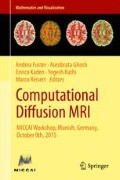Abstract
Diffusion magnetic resonance imaging (dMRI) has had a great impact on the study of the human brain connectome. Tractography methods allow for the reconstruction of white matter fiber tracts and bundles across the brain, by tracing the estimated direction of water diffusion across neighboring voxels. The tracts can then be used in conjunction with cortical parcellations to create structural connectivity matrices, to map the pattern and distribution of connections between cortical regions. However, the reliability of connectivity matrices is unclear. Tractography results depend on image resolution, and some reconstruction methods used to resolve the voxel-wise microstructure may be more robust to changes in resolution than others, leading to more stable connectivity estimates. We examined the reliability of structural connectivity matrices in 20 healthy young adults imaged with both high and low-resolution dMRI at two time points. We found that the Constrained Spherical Deconvolution (CSD) model produces the most reliable connections for both lower resolution and high resolution scans.
Access this chapter
Tax calculation will be finalised at checkout
Purchases are for personal use only
References
Hagmann, P., Cammoun, L., Gigandet, X., Meuli, R., Honey, C.J., et al.: Mapping the structural core of human cerebral cortex. PLoS Biol. 6(7), e159 (2008)
Basser, P., et al.: MR diffusion tensor spectroscopy and imaging. Biophys. J. 66(1), 259–267 (1994)
Kreher, B., Schneider, J., Mader, I., Martin, E., Hennig, J., Il’yasov, K.: Multitensor approach for analysis and tracking of complex fiber configurations. Magn. Reson. Med. 54, 1216–1225 (2005)
Aganj, I., et al.: Reconstruction of the orientation distribution function in single- and multiple-shell q-ball imaging within constant solid angle. Magn. Reson. Med. 64, 554–556 (2010)
Wedeen, V.J., et al.: Mapping complex tissue architecture with diffusion spectrum magnetic resonance imaging. Magn. Reson. Med. 54(6), 1377–1386 (2005)
Jahanshad, N., et al., Diffusion imaging protocol effects on genetic associations. Proc. IEEE Int. Symp. Biomed. Imaging 944–947 (2012)
Tournier, J.D., Calamante, F., Connelly, A.: Robust determination of the fibre orientation distribution in diffusion MRI: non-negativity constrained super-resolved spherical deconvolution. Neuroimage 35(4), 1459–1472 (2007)
Behrens, T.E.J., Johansen-Berg, H., Jbabdi, S., Rushworth, M.F.S., Woolrich, M.W.: Probabilistic diffusion tractography with multiple fibre orientations. What can we gain? Neuroimage 34(1), 144–155 (2007)
Daducci, A., Canales-Rodríguez, E.J., et al.: Quantitative comparison of reconstruction methods for intra-voxel fiber recovery from diffusion MRI. IEEE Trans. Med. Imaging 33(2), 384–399 (2014)
Côté, M.A., Girard, G., et al.: Tractometer: towards validation of tractography pipelines. Med. Image Anal. 17, 844–857 (2013)
Manjon, J.V., et al.: Adaptive non-local means denoising of MR images with spatially varying noise levels. J. Magn. Reson. Imaging 31(1), 192–203 (2010)
Benjamini, Y., Hochberg, Y.: Controlling the false discovery rate—a practical and powerful approach to multiple testing. J. R. Stat. Soc. B Met 57, 289–300 (1995)
Baumgartner, C., et al.: A unified tractography framework for comparing diffusion models on clinical scans. In: Proceedings of CDMRI 2012. 15th International Conference on Medical Image Computing and Computer Assisted Interventions, Nice (2012)
Yo, T.S., Anwander, A., et al.: Quantifying brain connectivity: A comparative tractography study. In: Medical Image Computing and Computer-Assisted Intervention – MICCAI 2009. Lecture Notes in Computer Science, vol. 5761, pp. 886–893 (2009)
Author information
Authors and Affiliations
Corresponding author
Editor information
Editors and Affiliations
Rights and permissions
Copyright information
© 2016 Springer International Publishing Switzerland
About this paper
Cite this paper
Villalon-Reina, J.E. et al. (2016). Reliability of Structural Connectivity Examined with Four Different Diffusion Reconstruction Methods at Two Different Spatial and Angular Resolutions. In: Fuster, A., Ghosh, A., Kaden, E., Rathi, Y., Reisert, M. (eds) Computational Diffusion MRI. Mathematics and Visualization. Springer, Cham. https://doi.org/10.1007/978-3-319-28588-7_19
Download citation
DOI: https://doi.org/10.1007/978-3-319-28588-7_19
Published:
Publisher Name: Springer, Cham
Print ISBN: 978-3-319-28586-3
Online ISBN: 978-3-319-28588-7
eBook Packages: Mathematics and StatisticsMathematics and Statistics (R0)

